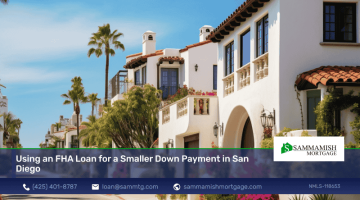No Obligation and transparency 24/7. Instantly compare live rates and costs from our network of lenders across the country. Real-time accurate rates and closing costs for a variety of loan programs custom to your specific situation.

Many first-time home buyers opt for a loan backed by the Federal Housing Administration (FHA.) FHA loans make it easier to get financing, permit a lower down payment, and are flexible for applicants with less than perfect credit scores. However, there may come a point when a conventional mortgage makes more sense.
FHA loans do mandate certain provisions which can add to the monthly cost of your mortgage, typically by requiring private mortgage insurance (PMI) for the duration of the loan. Refinancing into a conventional mortgage can remove this requirement and may also help you obtain a lower interest rate.
An FHA loan can be refinanced to a conventional loan as long as you meet minimum equity requirements. Typically, you’ll need to have 20% equity in your home, and have reached a 78% loan-to-value (LTV) ratio. This is fairly easily achieved if you are already some years into your home loan.
If these conditions are met, you can refinance from an FHA to a conventional loan and also remove the FHA requirement for mortgage insurance. If you don’t quite meet the equity minimum for a conventional loan, you may be able to refinance but will need to continue paying for PMI until you reach the 78% LTV threshold for discontinuance.
FHA loans require two separate types of private mortgage insurance premium payments.
An upfront mortgage insurance premium (UFMIP) is due as a one-time payment at closing. The UFMIP costs roughly 1.75% of your FHA loan’s principal balance. For example, the up-front cost on a $200,000, 30-year fixed FHA loan with 3.5% down would be equal to a $3,500 upfront mortgage insurance premium.
An annual mortgage insurance payment (MIP) is further required for the life of the loan. This annual cost is typically split up and added to your monthly mortgage payment. The MIP starts at around 0.85% of your loan principal, and would increase your monthly payment by somewhat more than $100 a month on the above loan.
If you have an FHA loan but recently tipped over the 20% equity marker and reached a 78% LTV, it may not make sense for you to keep paying for PMI. Even $100 a month adds up over the years, and you could end up paying an extra $20,000 or more in PMI payments. Switching away from an FHA loan can eliminate these additional costs.
If your FHA loan was an adjustable rate mortgage (ARM) switching to a conventional mortgage from an FHA makes even more sense. By switching to a conventional fixed rate mortgage, you can lower your monthly payment. You might even be able to qualify for a cash-out option if your equity is high enough.
You will need to go through the conventional loan vetting process, which can mean providing updated documentation. You may also have to pay for a new appraisal of your home. If the LTV doesn’t allow you to meet equity requirements, you’ll still have to come up with the PMI payments until you hit 78%.
Expect to pay refinancing costs as well. These can amount to as much as 2-5% of the amount of your loan, and may not be able to be rolled into your loan amount. Make sure that you’ll still come out ahead if you’re refinancing to get out from under FHA costs.
If you can’t meet the requirements for a conventional loan but still want to refinance, an alternative option is to apply for an FHA Streamline Refinance. This program allows FHA homeowners trapped in a high-interest ARM or fixed-rate mortgage to refinance quickly and easily to take advantage of a lower rate without the complications of in-depth documentation, credit, or income verification.
If the value of your property has decreased, interest rates on an ARM keep going up, or your income has been reduced, you could be at risk for default. The Streamline program was designed specifically to help reduce loan defaults. If you want to apply for a Streamline FHA refi, you must:
You won’t be able to get a cash-out with an FHA Streamline refinance. You’ll also have to continue paying PMI, but any UFPMI will be absorbed into your new mortgage instead of being due up-front at closing.
For a FHA Streamline refi, you’ll also need to demonstrate a Net Tangible Benefit, which is your valid reason for refinancing. The benefit can be any of the following:
If you’re still not sure about which loan product is right for you, ask yourself the following questions:
Do you want to stop paying PMI? If so, a refi into a regular loan might be your best bet. The same applies if you have an ARM and want a lower, fixed interest rate.
If your equity is high, and you need to be able to access some cash, converting from an FHA to a conventional mortgage makes sense.
If you owe more on your home than it is currently worth, an FHA Streamline refinance probably is the best option for you.
Many lenders are tightening restrictions on conventional home loans, and a formerly adequate credit score mighty not now make the grade. In that case, your FHA loan might be as good as it gets.
Refinancing FHA loan to a regular loan means you’ll need to qualify for the regular loan. If you can’t provide documentation to prove you’re a good risk, sticking with an FHA Streamline might be the easiest way to better your situation.
The loan officers at Sammamish are skilled at helping homeowners find the right refinance option for their home loan. Whether you want to convert your FHA loan to a regular loan, or simply complete an FHA Streamline refi, we can help you find the solution that best suits your needs.
Sammamish Mortgage has been in business since 1992, and has assisted many home buyers in the Pacific Northwest. If you are looking for mortgage financing in Washington State, we can help. Sammamish Mortgage offers mortgage programs in Colorado, Idaho, Oregon and Washington.
Contact us if you have any mortgage-related questions or concerns. If you are ready to move forward, you can view rates, obtain a customized instant rate quote, or apply instantly directly from our website.


Whether you’re buying a home or ready to refinance, our professionals can help.
{hours_open} - {hours_closed} Pacific
No Obligation and transparency 24/7. Instantly compare live rates and costs from our network of lenders across the country. Real-time accurate rates and closing costs for a variety of loan programs custom to your specific situation.